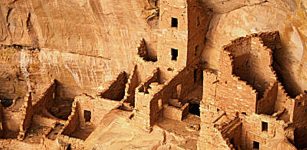200,000-Year-Old Grass Bed Discovered In South Africa’s Border Cave
Jan Bartek - AncientPages.com - Our ancestors understood the importance of having a comfortable bed and a good night's sleep.
A cave can provide shelter but sleeping on the ground is not very comfortable, so ancient people came up with a great idea. They created a bed made of grass that not only gave them comfort but also protected them from creepy insects.
Researchers in South Africa's Border Cave, a well-known archeological site perched on a cliff between eSwatini (Swaziland) and KwaZulu-Natal in South Africa, have found evidence that people have been using grass bedding to create comfortable areas for sleeping and working on at least 200,000 years ago.
These beds, consisting of sheaves of grass of the broad-leafed Panicoideae subfamily were placed near the back of the cave on ash layers.

The Border Cave in South Africa. Credit: Wits University
The layers of ash was used to protect the people against crawling insects while sleeping. Today, the bedding layers are visually ephemeral traces of silicified grass, but they can be identified using high magnification and chemical characterization.
"We speculate that laying grass bedding on ash was a deliberate strategy, not only to create a dirt-free, insulated base for the bedding, but also to repel crawling insects," says Professor Lyn Wadley, principal researcher and lead author.
"Sometimes the ashy foundation of the bedding was a remnant of older grass bedding that had been burned to clean the cave and destroy pests. On other occasions, wood ash from fireplaces was also used as the clean surface for a new bedding layer."
"We know that people worked as well as slept on the grass surface because the debris from stone tool manufacture is mixed with the grass remains. Also, many tiny, rounded grains of red and orange ochre were found in the bedding where they may have rubbed off human skin or colored objects," says Wadley.

Credit: Wits University
Modern hunter-gatherer camps have fires as focal points; people regularly sleep alongside them and perform domestic tasks in social contexts. People at Border Cave also lit fires regularly, as seen by stacked fireplaces throughout the sequence dated between about 200,000 and 38,000 years ago.
See also: More Archaeology News
"Our research shows that before 200,000 years ago, close to the origin of our species, people could produce fire at will, and they used fire, ash, and medicinal plants to maintain clean, pest-free camps. Such strategies would have had health benefits that advantaged these early communities," says the international team of researchers behind this study in a press statement.
Although hunter-gatherers tend to be mobile and seldom stay in one place for more than a few weeks, cleansing camps had the potential to extend potential occupancy.
Written by Jan Bartek - AncientPages.com Staff Writer




















